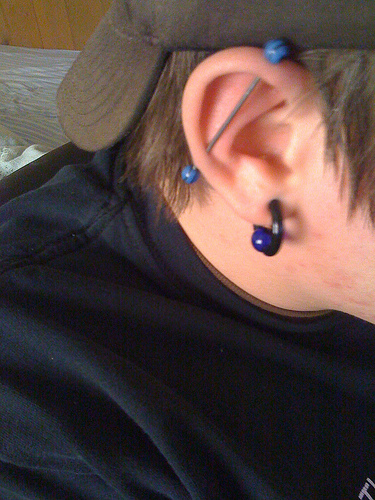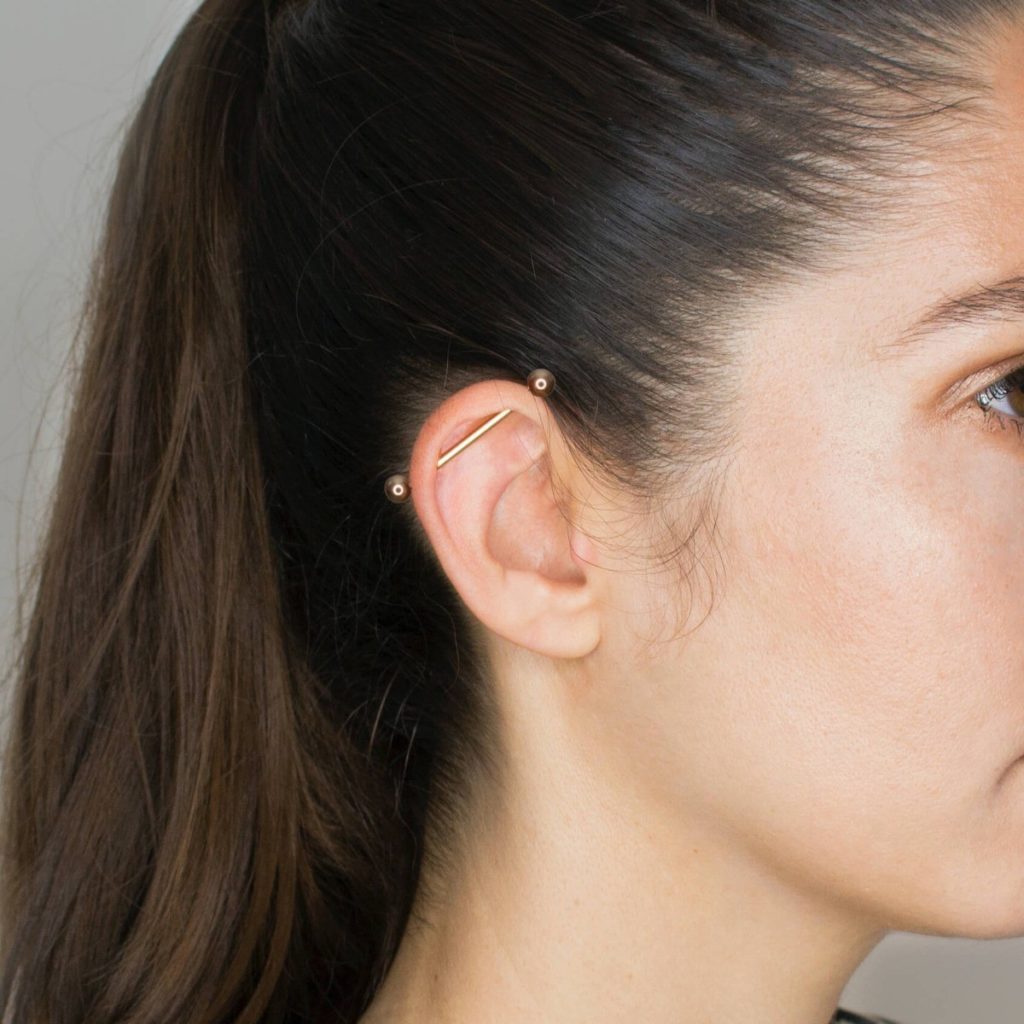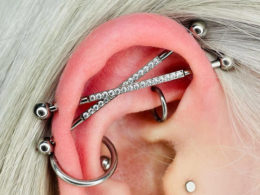Table of Contents Show
An industrial piercing is a popular and remarkable ear piercing type that consists of two piercings in one but it is still referred to as one. It is sometimes referred to as a scaffold piercing or a construction piercing, it is done by piercing the outer helix and forward helix and joining them as one with the use of straight jewelry that is held in place by beads at both ends.
Industrial piercings make contact with the ear cartilage on both holes and this makes the healing time longer than other piercings would take.
Despite the fact that it would require a lot of consistency and health caution to nurse an industrial piercing, more people are embracing the idea of it and getting theirs done every day. This means more people need accurate information on how to manage their industrial piercings, especially during the healing process.
One of the things that guarantee a healthy recovery for your ear after an industrial piercing is knowing the right jewelry to use, and knowing which jewelry types to completely stay clear of to avoid complications.
The Worst Jewelry For Industrial Piercings
Everybody wonders what jewelry is best suited for their new piercings, but you should equally have adequate information on which piercings are least appropriate for your new body piercing. Several people have issues with healing as early as other persons with the same piercings they have on, and sometimes this is as a result of their cheap and unhealthy jewelry choice.
You would need to know which jewelry types are not just attractive but compatible based on their metal components with your body piercing. Below are the worst jewelry choices for industrial piercings;
1. Sterling Silver

Sterling silver is an important metal to the site when talking about jewelry that is unsafe for fresh piercings. Many people have a liking for silver and can not afford pure silver so they tend to lean towards sterling silver as a jewelry choice for their new piercings.
Sterling Silver is unfortunately not a suitable choice for fresh piercings, it has some oxidation properties that make it an unhealthy choice for body piercings. Sterling Silver might have an impressive concentration of 92.5 percent silver, but it also contains other elements that are dangerous to the skin while a piercing is healing especially.
Your first jewelry for a body piercing should not be Sterling Silver, if you have a special liking for silver you would need to purchase jewelry made with pure silver instead.
2. Iron
Iron is a low-grade metal for making jewelry, it is better suited for equipment used for different jobs or household repairs. As a metal used in jewelry, iron rusts easily when in contact with body fluids such as sweat.
Asides from the rusting, it reacts very easily to anything it comes in contact with and this could lead to infections or severe allergic reactions. Iron scratches easily and this attribute is also a trigger for infections, redness, itching, and other allergic reactions.
3. Plated Gold
Plated gold is a cheaper option for persons that can not afford 14k or 18k gold but would like to hold jewelry.
While this may be a safe choice for neck and wrist jewelry, it is a harmful option for any type of body piercings. While it may look like real gold when purchased, it is not real gold and does not contain any of the hypoallergenic qualities of real gold that makes it safe for wearing on body and piercings.
Plated gold ends up flaking and exposing your skin to the inner metal which would result in infections and adverse reactions if the metal underneath is not inert. You can try plated gold when your piercing is fully healed but you must not wear it for long periods as it could still result in irritation, skin discoloration around your piercing, and itching in some cases.

4. Copper
Copper is another low-grade metal that is unsafe to wear on body piercings. Copper is usually present in gold or silver plated jewelry and when the skin is exposed to it, it results in skin reactions.
Nickel allergies are the most common metal allergy and copper is concentrated with a lot of nickels, which makes it particularly dangerous for the skin. Having on copper jewelry while your piercing is still healing can even lead to a rejection, in reaction to the infections, itching, and irritations your immune system will completely reject the piercing where the copper jewelry is being used on.
The oxidation of copper could also lead to skin discoloration. Wearing copper jewelry in your body piercings for long usually leaves it looking green and unpleasant. This color change is the skin’s normal reaction to being exposed to copper for a prolonged period and a sign to have it taken off.
Copper is also prone to tarnishing as a reactive metal, making it look unattractive and leaving unwanted residue that is unhealthy for your body piercing.
5. Nickel metals
Nickel is a strong, shiny, silvery-white metal that is ductile and malleable that it is merged with different metals to make them stronger. However, in a case where those metals are being used for jewelry that would be used on body piercings, it is unsafe. Metals such as copper, tin, zinc, and brass that contain nickels are dangerous for the skin.
Nickel allergies could result in adverse health issues because nickel has no biocompatibility with the skin. Nickel jewelry when in contact with body piercings could cause a skin rash known as contact dermatitis. Despite being affordable, nickel in jewelry has so many disadvantages that make it undesirable. For ear piercings, in particular, nickel jewelry causes a great deal of discomfort and constant irritation.
The worst jewelry type you can have on while your piercing is undergoing the healing phase is one that contains nickels, it would make the process unbearable and would increase the healing period after you have contracted infections and had to treat them. Nickel jewelry is also a cause for piercing rejection, your body would fight the discomfort by rejecting and seeking to close up the piercing completely as a defensive mechanism.
In Summary
An industrial piercing is already twice the struggle that a single piercing would require to heal safely, why make it harder by opting for cheap and unhealthy metal choices like those highlighted above?
This is one of the instances where opting for the cheaper option will only result in problems that would end up costing you more than you would have initially spent on getting high-quality jewelry.
To smoothen the healing process of your industrial piercing, choosing the right jewelry is of grave importance if you do not want to attract allergic reactions or a case of rejection. For emphasis, you need to run away when you are offered nickel concentrated jewelry no matter how appealing it may appear.
Nickels are your worst enemy while healing from a piercing, industrial piercings need extra care and this jewelry with nickels will make your efforts in following up on aftercare routine go to waste.
More piercing guides:













